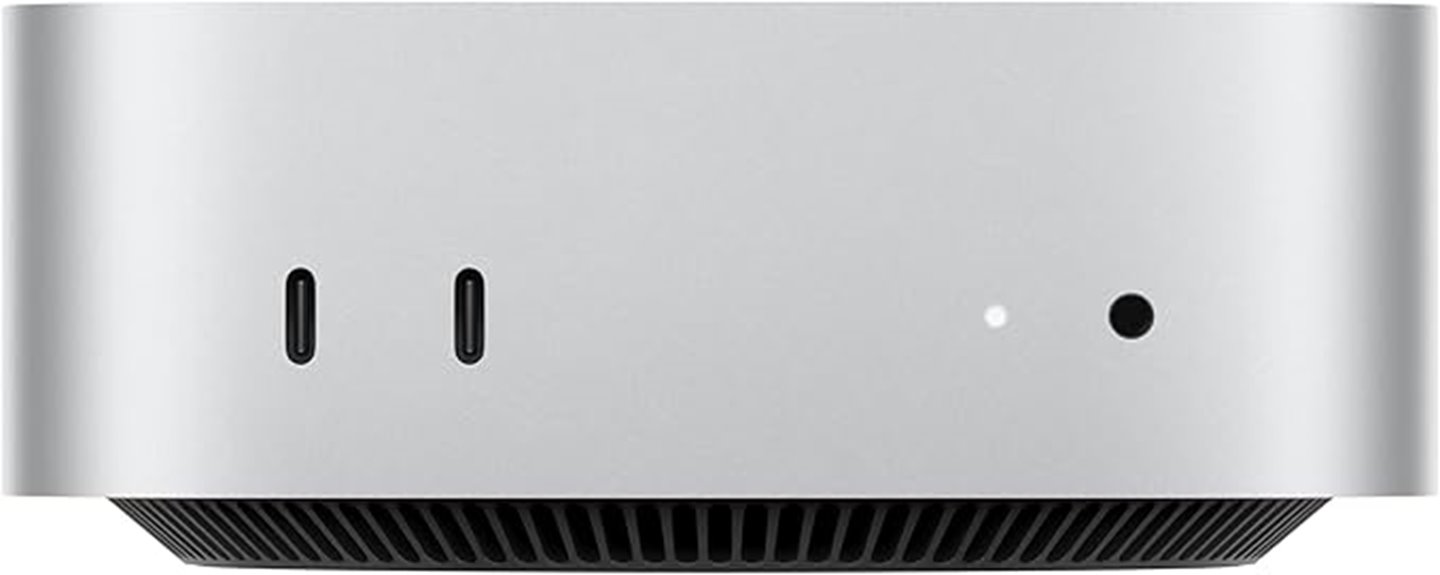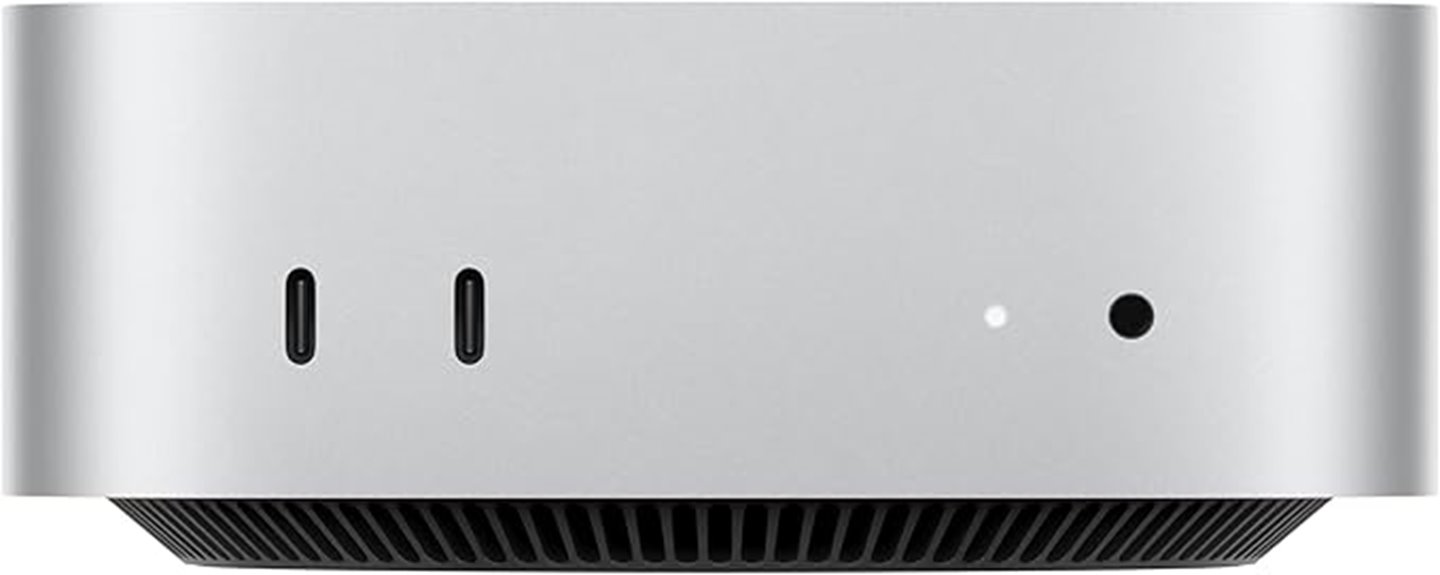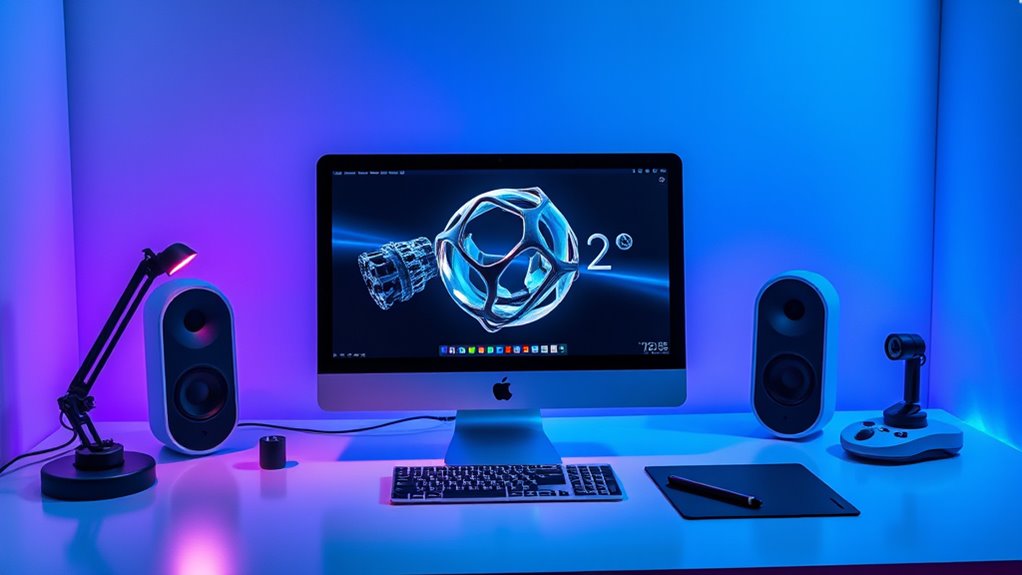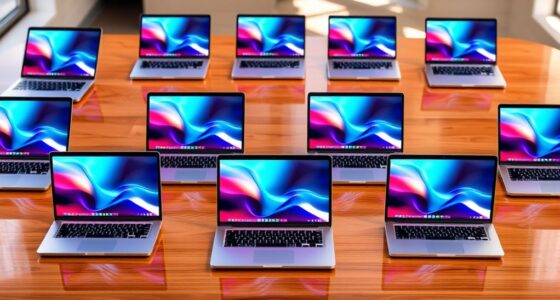If you’re looking for the best Mac models for 3D rendering in 2025, I recommend options like the Apple Mac mini with M4 Pro, which offers a powerful 12-core CPU and 16-core GPU in a compact design, perfect for demanding workflows. The standard M4 Mac mini with 16GB RAM and 512GB SSD is also a strong choice for lighter loads. If you want maximum performance, check out those with more RAM and storage. Keep reading to discover how these models excel in power, performance, and precision.
Key Takeaways
- Focus on models with M4 Pro chips, offering high-core CPU and GPU configurations for demanding rendering tasks.
- Prioritize systems with at least 24GB of unified memory and fast SSD storage for smooth workflows.
- Ensure multiple Thunderbolt ports and external GPU support for expanded connectivity and enhanced graphics performance.
- Opt for configurations supporting hardware-accelerated ray tracing and Metal API compatibility for realistic rendering.
- Consider models with a balanced mix of power, expandability, and future-proof features within your budget.
Apple 2024 Mac mini Desktop Computer with M4 Chip

If you’re looking for a compact yet powerful machine for 3D rendering in 2025, the Apple 2024 Mac mini with M4 chip is an excellent choice. Its small five-by-five-inch design fits easily next to your monitor, making it highly portable and space-efficient. Powered by Apple’s M4 chip, it offers a 10-core CPU, 10-core GPU, and 16GB of unified memory, delivering impressive performance for demanding tasks. It supports up to three displays and features fast storage options. Despite its size, it runs quietly and stays cool under load. This mini desktop seamlessly integrates into the Apple ecosystem, making it ideal for smooth, efficient 3D rendering workflows.
Best For: professionals and enthusiasts seeking a compact, high-performance desktop for demanding tasks like 3D rendering, video editing, and multitasking within the Apple ecosystem.
Pros:
- Small, space-efficient design that easily fits next to a monitor and is highly portable
- Powerful M4 chip with a 10-core CPU and GPU, offering exceptional performance for demanding workflows
- Quiet operation and cooler running under load, ensuring minimal noise during intensive tasks
Cons:
- Limited RAM and storage upgrade options, which may require external drives or cloud solutions for expanded capacity
- Only supports up to three displays, which might be restrictive for multi-monitor setups
- Lacks dedicated graphics options outside the integrated GPU, potentially limiting performance in highly graphics-intensive applications
Apple Mac mini Desktop Computer with M4 Chip

The Apple Mac mini with M4 chip stands out as an ideal choice for users who need powerful performance in a compact form factor. Measuring just 5×5 inches, it fits easily next to any monitor or workspace. Equipped with a 10-core CPU and GPU, 24GB of unified memory, and 512GB SSD storage, it handles multitasking and demanding tasks effortlessly. Its versatile ports—including Thunderbolt, HDMI, USB-C, Ethernet, and headphone jack—ensure seamless connectivity. Running macOS with optimized Apple Silicon support, it integrates smoothly with the Apple ecosystem, offering enhanced productivity, privacy, and security—all packed into a small yet mighty device.
Best For: professionals and creatives who need powerful performance in a compact, space-saving desktop that seamlessly integrates with the Apple ecosystem.
Pros:
- Compact size fits easily in any workspace or next to monitors
- Powerful 10-core CPU and GPU deliver fast, efficient performance for demanding tasks
- Extensive connectivity options including Thunderbolt, HDMI, USB-C, Ethernet, and headphone jack
Cons:
- Limited upgradeability due to integrated design and Apple Silicon architecture
- Higher price point compared to some similar-sized PCs with Intel or AMD processors
- Limited internal storage options beyond the base 512GB SSD for future expansion
Apple Mac mini 2024 Desktop with M4 Chip, 16GB RAM, 512GB SSD

The Apple Mac mini 2024 with M4 chip, 16GB RAM, and 512GB SSD stands out as an ideal choice for those seeking a compact yet powerful machine for 3D rendering, especially in space-constrained setups. Its sleek, five-by-five-inch design fits easily beside monitors or in tight spaces, while remaining quiet and cool under load. Powered by the M4 chip with a 10-core CPU and GPU, it offers fast app launches and smooth rendering. Support for multiple high-resolution displays and extensive connectivity options makes it versatile. Although non-upgradable, its performance and integration within the Apple ecosystem make it a reliable, space-efficient solution for light to moderate 3D work.
Best For: users seeking a compact, high-performance desktop for light to moderate 3D rendering and creative tasks within the Apple ecosystem.
Pros:
- Compact, space-saving design that fits easily in small setups
- Powerful M4 chip with 10-core CPU and GPU for fast rendering and app performance
- Supports multiple high-resolution displays and extensive connectivity options
Cons:
- Non-upgradable RAM and storage limits future expandability
- Setup can be challenging with external monitors or specific cables for some users
- Primarily designed for light to moderate tasks, may not handle intensive 3D rendering workloads seamlessly
Apple Mac mini Desktop Computer with M4 Pro chip

For those seeking a compact yet powerful workstation, the Apple Mac mini Desktop Computer with M4 Pro chip delivers impressive performance in a small footprint. Featuring a 12-core CPU and 16-core GPU, it handles demanding tasks like 3D rendering and large code compilations with ease. With 24GB of unified memory and a 512GB SSD, multitasking and data access are swift. Its five-by-five-inch design fits easily next to monitors or in tight spaces. Equipped with Thunderbolt, HDMI, USB-C, and Ethernet ports, it integrates seamlessly into any workspace. Powered by Apple Silicon, it offers efficient performance, robust privacy protections, and excellent compatibility with the Apple ecosystem.
Best For: professionals and creatives who need a compact, powerful workstation capable of handling demanding tasks like 3D rendering, large code compilations, and multitasking within a small space.
Pros:
- Compact size fits easily into any workspace or next to monitors.
- Powerful M4 Pro chip with 12-core CPU and 16-core GPU for demanding performance.
- Seamless integration with the Apple ecosystem and robust privacy protections.
Cons:
- Limited upgradeability due to integrated hardware design.
- Higher price point compared to some other compact desktops with similar specs.
- Might be overpowered for basic tasks, leading to underutilization of its capabilities.
Factors to Consider When Choosing a Mac Studio for 3D Rendering

When selecting a Mac Studio for 3D rendering, I focus on processing power, graphics capabilities, and how much memory and storage I need. Connectivity options and expansion possibilities also matter, especially for handling large projects. Ultimately, ensuring compatibility with my software is essential to optimize performance and workflow.
Processing Power Needs
Choosing the right Mac Studio for 3D rendering hinges on understanding its processing power. I look for models with higher core counts, like 12 cores or more, because they markedly cut down rendering times for complex scenes. A robust GPU with hardware-accelerated ray tracing is vital for real-time visualization and top-quality output. I also prioritize having at least 16GB of RAM to handle large textures and complex models smoothly. Fast storage options, such as SSDs, are indispensable to reduce load times and streamline workflows. Ultimately, I evaluate how well the CPU and GPU work together, as a balanced architecture ensures my Mac Studio can efficiently tackle demanding rendering tasks without bottlenecks or delays.
Graphics Capabilities
The GPU is the cornerstone of a Mac Studio’s graphics capabilities, especially for demanding 3D rendering tasks. High-performance options like a 16-core or higher Apple Silicon GPU or discrete AMD Radeon Pro cards drastically cut rendering times and boost visual fidelity. Hardware-accelerated ray tracing support in these GPUs creates realistic lighting, shadows, and reflections in complex scenes. The amount of VRAM directly impacts how well the system handles large textures and intricate models without slowing down. Additionally, Mac Studios can connect to external high-performance GPUs via Thunderbolt, expanding their rendering power for specialized workflows. When choosing a Mac Studio, prioritizing a powerful GPU with ample VRAM guarantees smoother rendering and better visual results in 3D projects.
Memory and Storage Options
Opting for ample memory and storage is crucial for smooth 3D rendering on a Mac Studio. Larger memory, like 32GB or more, helps handle complex projects efficiently, reducing lag and improving multitasking. The unified memory architecture allows for faster data access, making intensive rendering tasks smoother. Sufficient storage, such as 1TB or higher, ensures you can store large project files, textures, and outputs without constantly relying on external drives. Upgrading storage during purchase guarantees enough space and streamlines your workflow. External SSDs can also expand capacity and boost data transfer speeds for especially large projects. Prioritizing these options means you won’t face bottlenecks or storage shortages, keeping your 3D rendering process seamless and efficient.
Connectivity and Expansion
Since efficient connectivity is vital for handling large 3D rendering projects, I focus on guaranteeing my Mac Studio has multiple Thunderbolt 4 ports, which support high-speed data transfer critical for moving complex files quickly. I also check for enough USB-C and HDMI ports to connect external displays, peripherals, and power sources simultaneously, keeping my workspace streamlined. High-bandwidth Ethernet options like 10Gb Ethernet are essential for rapid file sharing and network rendering tasks, so I verify their availability. Additionally, I consider expandability with external SSDs to handle massive project files and guarantee quick data access. Finally, I evaluate the port layout to make sure they are conveniently located for my workspace setup, enabling seamless connection of multiple peripherals and monitors without clutter.
Compatibility With Software
Choosing a Mac Studio that’s compatible with your 3D rendering software is vital for smooth workflow and ideal performance. First, check that the GPU or GPU options support your software’s hardware acceleration needs, ensuring fast rendering times. Make sure your macOS version aligns with the latest release of your applications to avoid compatibility issues. It’s also indispensable to verify if your software supports Metal, Apple’s graphics API, which greatly optimizes performance on Macs. Additionally, confirm that the hardware specifications meet or surpass the recommended system requirements for your specific software. Don’t forget to review compatibility notes for plugins, add-ons, or third-party tools you rely on, so everything integrates seamlessly without causing workflow disruptions. Proper compatibility guarantees a smooth, efficient rendering experience.
Budget and Value
When selecting a Mac Studio for 3D rendering, it’s essential to take into account the total cost, including optional upgrades like additional RAM and storage, to guarantee it fits within your budget. I recommend evaluating the performance-to-price ratio by comparing hardware capabilities with the overall price, ensuring you get the best value for your investment. Look for models offering a strong balance of high-performance components, such as the M4 Pro chip and ample RAM, relative to their cost. Don’t forget to consider long-term value—how well the system can handle future rendering projects without immediate upgrades. Additionally, factor in extra expenses like external storage or peripherals, as these can greatly impact your overall investment and workflow efficiency.
Frequently Asked Questions
How Does GPU Performance Impact 3D Rendering Quality on Mac Studios?
GPU performance directly impacts my 3D rendering quality by speeding up complex calculations and improving visual detail. A powerful GPU allows me to handle high-resolution textures, intricate lighting, and detailed models without lag. When my GPU is robust, I notice smoother workflows, faster rendering times, and more realistic results. It’s essential for achieving precision and efficiency in my projects, especially with demanding, high-quality 3D visuals.
What Is the Ideal RAM Size for Intensive 3D Rendering Tasks?
For intensive 3D rendering, I recommend at least 64GB of RAM, but 128GB is even better for complex projects. Think of RAM as your workspace; more space means smoother multitasking and faster rendering. If you’re working with high-res textures or large models, investing in higher RAM prevents slowdowns and crashes. So, don’t skimp—more RAM guarantees your Mac Studio handles demanding tasks effortlessly and keeps your workflow flowing.
Are External GPUS Compatible With Mac Studio for Enhanced Rendering?
Yes, external GPUs can be compatible with Mac Studio, but it depends on the model and connection options. I’ve found that Thunderbolt 3 or 4 ports are essential for peak performance. Keep in mind that macOS support for eGPUs has improved, but not all GPU brands or models work seamlessly. I recommend checking compatibility before investing, ensuring your workflow benefits from the extra power.
How Does Thermal Management Affect Long Rendering Sessions on Mac Studio?
Thermal management is essential during long rendering sessions because it helps prevent overheating, which can throttle performance and cause system instability. I’ve noticed that Mac Studio’s efficient cooling system maintains ideal temperatures, allowing me to work longer without performance dips. Good airflow and ambient conditions also matter, so I make sure my workspace is well-ventilated. Proper thermal management keeps my Mac Studio running smoothly, ensuring my projects stay on track.
What Software Optimizations Are Available for Mac Studio’s Hardware?
I optimize my Mac Studio’s hardware by keeping software up to date, which guarantees I benefit from the latest performance improvements. I also use rendering software that leverages Metal, Apple’s graphics API, for better efficiency. Additionally, I tweak settings like cache sizes and enable hardware acceleration when available. These steps help me get the most out of my Mac Studio, making my 3D rendering smoother and faster.
Conclusion
Choosing the right Mac Studio for 3D rendering means balancing power, performance, and precision. Whether it’s the compact Mac mini with M4, the upgraded M4 Pro, or other top-tier models, each offers unique strengths. Think of them as tools in a toolkit—each designed to handle different demands. By matching your project needs with these models’ capabilities, you’ll guarantee smooth workflows, faster rendering, and stunning results every time.









